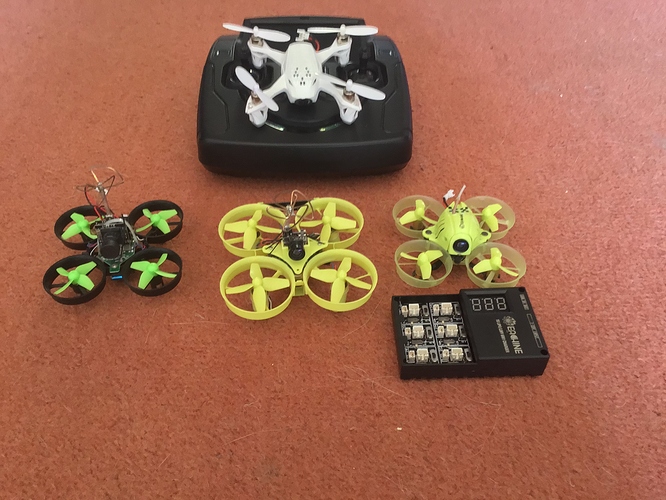Getting started with fpv can be challenging. There are a vast amount of things to learn from how the tech works to maintenance and that’s before you even get in the air for the first time.
Now truth be told I’m not the biggest micro fan. I keep trying them but keep not finding them as fun as my larger more powerful quads. I will as always try and recommend good quality without bias towards a specific brand.
So if you already have a transmitter, goggles charger etc (some recommendations are in my fpv101 thread) your choices are pretty endless
If however you are starting from scratch then one of the rtf bundles will get you started.
There are 2 types of micro fpv quad
Brushed and brushless I will try and explain the pros and cons of each…
Brushed
Brushed motors are where tinywhoop’s really came from. They are cheep and reliable. They are also the lightest of the micro quads. On the flip side they also wear out and need replacing when the brushes wear out. I also find them horrendously underpowered (some day that’s the charm of tinywhoops)
Brushless
Brushless motors are where everyone is moving to now. They are more expensive than brushed motors but they also don’t ‘wear out’. They also generate more thrust than brushed. Downsides include power consumption (they are hungry motors). They are heavy on comparison to brushed.
All in all I would be looking at brushless if buying today.
Size…
Size is important. Micro quads vary from about 65mm wheelbase to around 110mm. The larger the quad the harder it is to fly indoors as bigger quads have more powerful motors and bigger props. So you need to think about where you want to fly it.
Ducts
All the “whoop” class quads use ducted props. The idea being that the ducts help produce more thrust on each motor increasing efficiency. In practice however most quads it’s more a thing to prevent you from damaging things you will bump into. The ducts also act a bit like sales in the wind. All whoop class quads have ducts. It does mean that you can fly around your house and not worry to much about scratching the wallpaper or damaging that expensive tv!
Batteries…
Most whoop class quads run on 1 or 2s batteries. Looking after them is at best a pain in the… I recommend treating them like consumables and replace often.
Rtf vrs bind n fly
Nearly all of the rtf packages come with horrific controllers and your going to have a bad time trying to fly them. The notable exception being the eMax tinyhawk series. They come with a basic but useable controller (you will however outgrow this pretty quickly). The rtf bundles all come with some Google’s. Again they are functional but not brilliant. They will be fine for getting started but if you want to improve then goggles will end up on your shopping list pretty quickly.
Bnf
Bind n fly is where most people go. That way they can use there own controller and goggles. Worth noting that the latest frsky transmitters do not support “d8” mode and should be avoided (grab a jumper t16pro instead) the biggest advantage is your controller will grow with you and you will be able to use it on many many models.
So my top pick for a getting started micro quad…
The eMax tinyhawk either as the rtf bundle or as a bind n fly.
Remember to stock up on extra batteries and happy flying
Any questions let me know and I will try and help 
If you want me to cover this in greater detail I will be talking micros on my next live stream.
Thanks
Wyntrbluefpv

